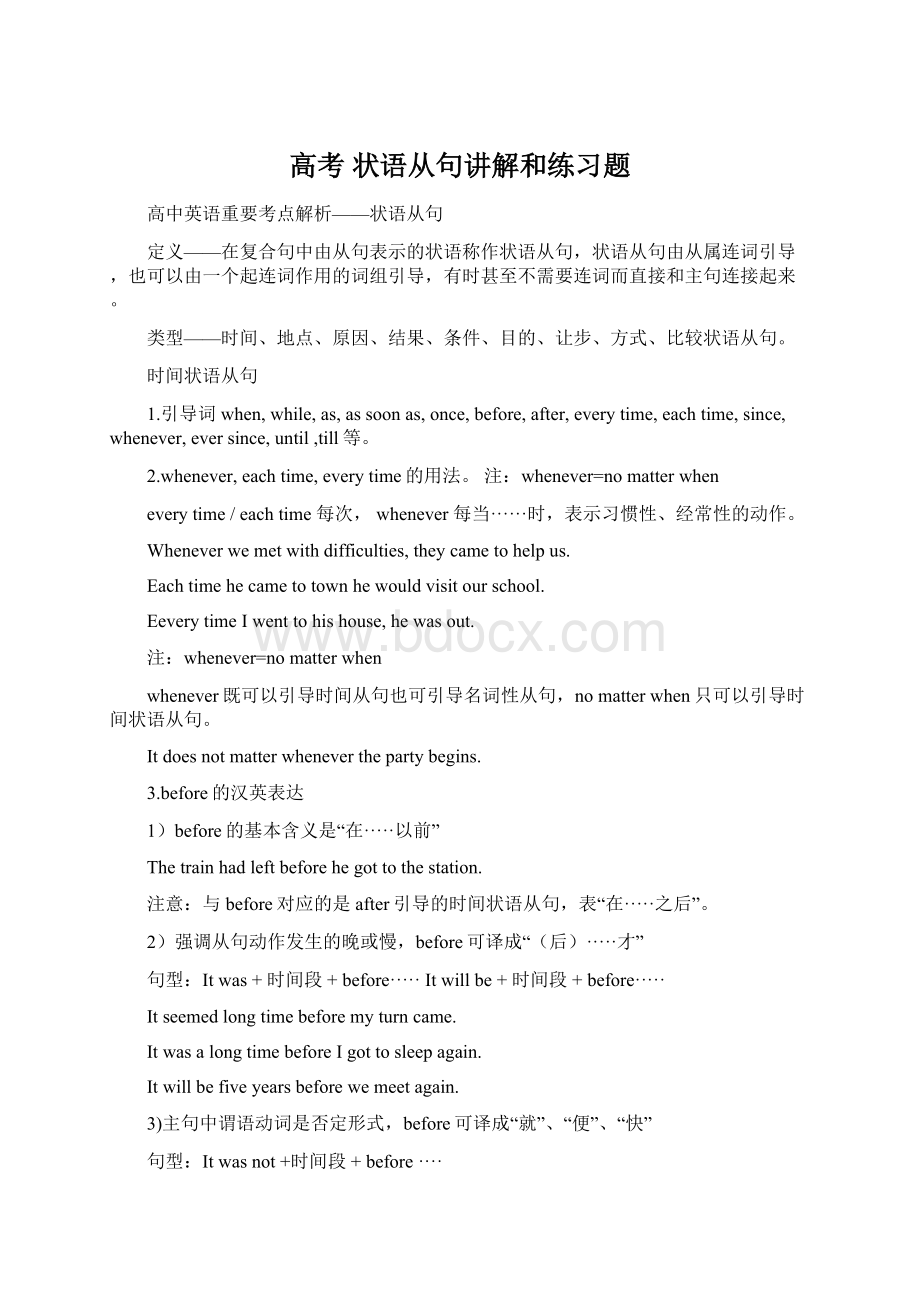高考 状语从句讲解和练习题.docx
《高考 状语从句讲解和练习题.docx》由会员分享,可在线阅读,更多相关《高考 状语从句讲解和练习题.docx(16页珍藏版)》请在冰豆网上搜索。

高考状语从句讲解和练习题
高中英语重要考点解析——状语从句
定义——在复合句中由从句表示的状语称作状语从句,状语从句由从属连词引导,也可以由一个起连词作用的词组引导,有时甚至不需要连词而直接和主句连接起来。
类型——时间、地点、原因、结果、条件、目的、让步、方式、比较状语从句。
时间状语从句
1.引导词when,while,as,assoonas,once,before,after,everytime,eachtime,since,whenever,eversince,until,till等。
2.whenever,eachtime,everytime的用法。
注:
whenever=nomatterwhen
everytime/eachtime每次,whenever每当······时,表示习惯性、经常性的动作。
Wheneverwemetwithdifficulties,theycametohelpus.
Eachtimehecametotownhewouldvisitourschool.
EeverytimeIwenttohishouse,hewasout.
注:
whenever=nomatterwhen
whenever既可以引导时间从句也可引导名词性从句,nomatterwhen只可以引导时间状语从句。
Itdoesnotmatterwheneverthepartybegins.
3.before的汉英表达
1)before的基本含义是“在·····以前”
Thetrainhadleftbeforehegottothestation.
注意:
与before对应的是after引导的时间状语从句,表“在·····之后”。
2)强调从句动作发生的晚或慢,before可译成“(后)·····才”
句型:
Itwas+时间段+before·····Itwillbe+时间段+before·····
Itseemedlongtimebeforemyturncame.
ItwasalongtimebeforeIgottosleepagain.
Itwillbefiveyearsbeforewemeetagain.
3)主句中谓语动词是否定形式,before可译成“就”、“便”、“快”
句型:
Itwasnot+时间段+before····
Itwon’tbe+时间段+before····(从句谓语动词用一般现在时)
Itwasnotlongbeforehegottoknowit.
Itwon’tbelongbeforewegetpromotion.
4)强调在从句动作发生之前,主句动作已经发生,before可译成“还没有····就”
BeforeIcouldsayasingleword,heranaway.
4.when,while,as的用法及区别
1)when表示“当····的时候”
从句中既可用延续性动词,又可用点动词,可表示动作,又可表示状态。
从句中的动词既可和主句的动作同时发生,又可在主句的动作之前或之后发生。
ImetTomwhenIwaswalkingalongthestreet.
1)如果when从句的主语与主句主语相同,谓语又是be动词,从句主语和be可以省略。
When(youare)introuble,askmeforhelp.
2)当when从句主语与主句主语相同时,用when加分词可以代替状语从句。
When(Iam)sleeping,Icanneverhearanything.
2.as表示“当····时”、“一边····一边”、“随着”
1)表示“当····时”、“与····同时”,指从句的动作未结束,主句中的动作就已发生。
从句中多用动态动词,而不用be动词或表示感觉、理解、知道这类动词。
Ashewaseatinghisbreakfast,heheardthedoorbellringing.(强调同一时间)
2)用于平行的动作中,表示“一边····一边····”,常指一个主语同时进行两个动作。
Thestudentstooknotesastheylistened.
3)表示“随着····”,常指两种正在发展或变化的情况。
Asspringwarmsthegoodearth,allflowersbegintobloom.
3.while表示“在····的时候”、“在····期间”
它强调主句的动作与从句的动作同时发生或强调主句表示的动作持续于while所指的整个时间内。
While从句中必须是延续性动词。
IwasreadingthebookwhilehewaswatchingTV.
1)如果主句的动作在从句的动作过程中发生,从句常用进行时。
Whilewewereswimming,someonestoleourclothes.
2)如果主句和从句主语相同,while加现在分词可代替状语从句。
Whilediscussingthematter,theygotveryexcited.
3)while有时还有对比的含义,意为“然而,却”。
WhileIwasreading,hewasplaying.
注意:
1.表示主句的动作发生在从句的较长动作过程中,用when,while,as。
Hewasfondofswimmingwhen(while)hewasyetachild.
Ashewasachild,hewasfondofswimming.
2.从句中为be动词时,多用when和while.
Don’ttalktoomuchwhen(while)youareeacting.
3.谈论两个同时进行的长时间动作可用while。
Whileheisintheoffice,heisalwaysserious.(严肃的)
4.谈论两个平行动作或两种状态变化多用as。
Thestudentsroseastheteacherenteredtheclassroom.
5.till和untill的用法。
在肯定句中表示“直到····为止”,主句需用延续性动词。
在否定句中表示“直到····才”,主句常用点动词。
1)till一般不用于句首
Let’swaittilltherainstops.Don’twakehimtillmidnight.
2)untilwhen疑问句中,untill要放在句首
——Untilwhenareyoustayinghere?
——UntilnextTuesday.
注意:
当until引起的状语修饰动词肯定式时,动词常是延续性动词;反之,修饰动词否定式时,动词常是点动词。
3)否定句可用另外两种句式表示
Notuntil····放在句首,主句用倒装。
Notuntilitwasdarkdidhecomeback.
Itisnotuntil···that···强调句型。
Itwasn’tuntilIbegantoworkthatIrealizedhowmuchtimeIhadwasted.
6.since(自从),eversince(自从)的用法
since表示自过去的一个起点时间到目前(说话时间)为止的一段持续时间。
主句一般用现在完成时,从句用一般过去时。
IhaveknownhersinceIhavelivedhere.
Hehasbeenilleversince.他自那以后一直生病。
句型:
Itis/hasbeen+时间段+since····(一般过去时)
Itis10yearssincehelivedhere.
7.表示“一····就····”的结构
Hardly/scarcely····when,nosooner····than,assoonas,theminute,themomemt,directly,immediately都可以表示“一····就····”的意思。
Ihadhardly/scarcelygothomewhenitbegantorain.=Ihadnosoonergothomethanitbegantorain.=AssoonasIgothome,itbegantorain.
Theoldworkerrecognizedthetypeofthemachinedirectlyhesawit.
注意:
如果hardly,scarcely或nosooner置于句首,主句必须用倒装结构。
HadlyhadIgothomewhenitbegantorain.=NosoonerhadIgothomethanitbegantorain.
Theperformancehadhardlybegunwhenthelightswentout.=Hardlyhadtheperformancebegunwhenthelightswentout.
条件状语从句
分为两大类:
真实条件句——当从句所表达的条件是有可能实现的、是真实的条件时,用真实条件句。
Ifitrainstomorrow,wewon’tholdasportsmeetingontheplayground.
IfIhavetime,Iwillcometohelpyou.
非真实条件句——当从句所表达的条件是不可能实现的、与客观事实完全相反的条件或假设时,用非真实条件句。
IfIhadknowntheansweratthattime,Iwouldhavetoldhim.
1.if,unless和if···not用法
条件状语从句可以由if,unless等词或词组引导。
Unless在意义上相当于if···not。
IfIhadenoughmoney,Iwouldbuyit.
Youwillfailunlessyoustudyhard.=Youwillfailifyoudon’tstudyhard.
Youwon’tbelateunlessheisill.=Hewon’tbelateifheisnotill.
注意:
虚拟条件句中可用if···not,但不能用unless。
Ifshewerenottoosilly,shewouldunderstand.
2.引导条件状语从句的其他连词
incase万一,so/aslongas只要,as/sofaras就···而言,onconditionthat条件是····,suppose假设,supposing假设等。
Sendusamessageinca